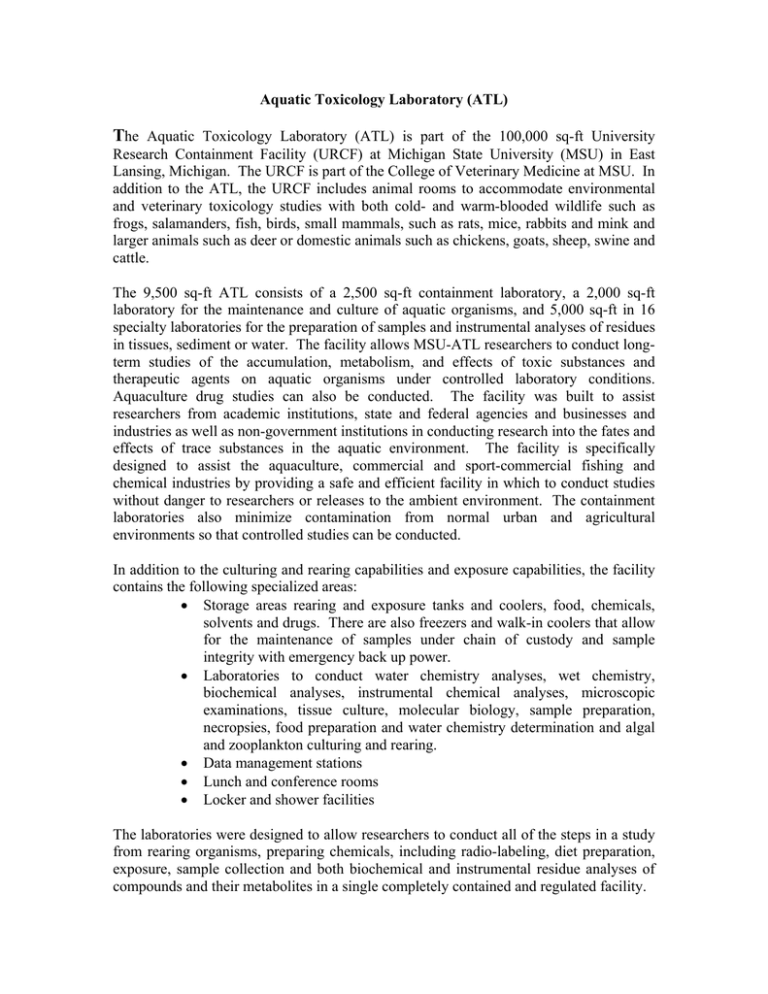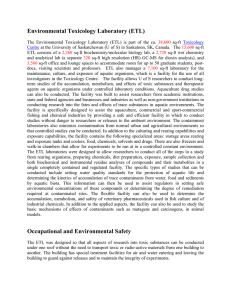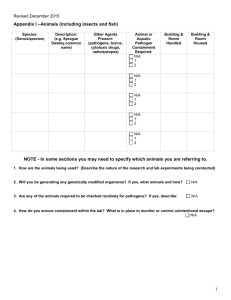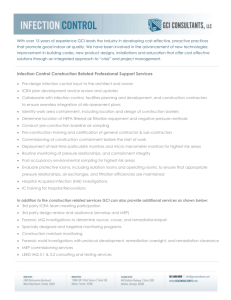T
advertisement

Aquatic Toxicology Laboratory (ATL) The Aquatic Toxicology Laboratory (ATL) is part of the 100,000 sq-ft University Research Containment Facility (URCF) at Michigan State University (MSU) in East Lansing, Michigan. The URCF is part of the College of Veterinary Medicine at MSU. In addition to the ATL, the URCF includes animal rooms to accommodate environmental and veterinary toxicology studies with both cold- and warm-blooded wildlife such as frogs, salamanders, fish, birds, small mammals, such as rats, mice, rabbits and mink and larger animals such as deer or domestic animals such as chickens, goats, sheep, swine and cattle. The 9,500 sq-ft ATL consists of a 2,500 sq-ft containment laboratory, a 2,000 sq-ft laboratory for the maintenance and culture of aquatic organisms, and 5,000 sq-ft in 16 specialty laboratories for the preparation of samples and instrumental analyses of residues in tissues, sediment or water. The facility allows MSU-ATL researchers to conduct longterm studies of the accumulation, metabolism, and effects of toxic substances and therapeutic agents on aquatic organisms under controlled laboratory conditions. Aquaculture drug studies can also be conducted. The facility was built to assist researchers from academic institutions, state and federal agencies and businesses and industries as well as non-government institutions in conducting research into the fates and effects of trace substances in the aquatic environment. The facility is specifically designed to assist the aquaculture, commercial and sport-commercial fishing and chemical industries by providing a safe and efficient facility in which to conduct studies without danger to researchers or releases to the ambient environment. The containment laboratories also minimize contamination from normal urban and agricultural environments so that controlled studies can be conducted. In addition to the culturing and rearing capabilities and exposure capabilities, the facility contains the following specialized areas: • Storage areas rearing and exposure tanks and coolers, food, chemicals, solvents and drugs. There are also freezers and walk-in coolers that allow for the maintenance of samples under chain of custody and sample integrity with emergency back up power. • Laboratories to conduct water chemistry analyses, wet chemistry, biochemical analyses, instrumental chemical analyses, microscopic examinations, tissue culture, molecular biology, sample preparation, necropsies, food preparation and water chemistry determination and algal and zooplankton culturing and rearing. • Data management stations • Lunch and conference rooms • Locker and shower facilities The laboratories were designed to allow researchers to conduct all of the steps in a study from rearing organisms, preparing chemicals, including radio-labeling, diet preparation, exposure, sample collection and both biochemical and instrumental residue analyses of compounds and their metabolites in a single completely contained and regulated facility. The specific types of studies that can be conducted include setting water quality standards for the protection of aquatic life and determining the kinetics of accumulation of trace contaminants from water, food and sediments by aquatic biota. This information can then be used to assist regulators in setting safe environmental concentrations of these compounds or determining the degree of remediation required at contaminated sites. The flexible facility can also be used to determine the accumulation, metabolism, and safety of veterinary pharmaceuticals used in fish culture and of industrial chemicals. In addition to the applied aspects, the facility can also be used to study the basic mechanisms of effects of contaminants such as mutagens and carcinogens, in animal models. The facility is actually a building within a building. The internal cement block structure is enclosed in an external metal shell. The facility is designed such that all of the utilities, water supply and air handling in on the second floor. All of the utilities come through the ceiling so that there is no interaction between electricity and water. All of the water flow is by gravity such that in the advent of an electrical failure the system continues to function until the emergency generator system is automatically activated. Occupational and Environmental Safety The Aquatic Toxicology Laboratory was designed so that all aspects of research into toxic substances can be conducted under one roof without the need to transport toxic or radio-active materials from one building to another. The entire facility is a high-security containment facility with many special features that meet or exceed all current guidelines for the protection of workers and the environment. The building has special treatment facilities for air and water entering and leaving the building to guar agains releases and to maintain the integrity of experiments. The building and all operations are overseen by a permanent facility manager. All animal studies are overseen by a permanent, AALAScertified technologist and state-licensed veterinarian. Culture Facilities The 2,000 sq-ft rearing laboratory is divided by moveable plastic curtains so that research areas can be configures in a variety of ways to accommodate and separate various experiments. The area can be set up as one large area or divided into 9 separate research areas. Lighting in each region of the laboratory is controlled by individual timers so that the duration of lighting can be regulated in each area separately. The room is equipped with a number of containers for rearing aquatic organisms including aquariums, 1,500-L and 2,500-L, round, fiberglass tanks and 1,000-L to 2,000-L rectangular tanks. The facilities are designed and equipped to allow both static- and continuous flow throughexposures with organisms ranging from phytoplankton, and zooplankton to benthic invertebrates, including insects and clams, fish and amphibians. Adult salmon as large as 10 kg can be accommodated. Influent water treatment The source of water for the facility is a well network that provides up to 450 L per minute. The well water is injected with pure oxygen to begin the saturation process and to provide excess oxygen to oxidize metals and begin their precipitation. Kinetically, the pure oxygen does this very efficiently. Gases, including N2, CO2 O2 and hydrogen sulfide are equilibrated to 100% saturation by an aerator tower. The water then goes to two underground, cement settling basins where they are further aerated to precipitate Iron oxide and allow the precipitate to settle out. The water then goes to chromic acid sand filter to further remove particulates. The iron free water then goes through a series of sand and activated charcoal filters. This treated fresh water (FW) then is passed through ultraviolet light banks to kill any possible pathogens, including spores. The FW and RO water can then be heater to up to 45 oC or cooled to 6 oC. Each tank or research area is plumbed with four water lines that deliver normal FW, heated and cooled FW and RO water. In addition to these four types of water, there are several additional larger capacity lines carrying treated freshwater. The water can be mixed at the tank to make any combination of hardness from 0 to 235 mg CaCO3/L and temperature from 6 to 45 oC. The rearing and containment rooms each contain a 108 sq-ft stainless steel controlled temperature room that researchers can use to maintain temperatures from 14 to 28 6 oC within 0.2 6 oC. Exposure Facilities The exposure area is similar in most respects to the culture area. The exposure rooms are equipped with heap filters in the influent and effluent air to maintain clean air in the laboratory while minimizing the chance that any toxicants would escape the containment room. The air exchange rate is 5 times per hour in the entire building, including the exposure rooms. In addition, the containment rooms include laminar flow hoods and fume hoods so that studies can be conducted with toxic chemicals, radioisotopes and genetically engineered organisms. There are two levels of containment for air in the exposure environment: 1) The containment laboratory is equipped with three computercontrolled solenoid type proportional-flow diluters. The diluters are under stainless steel hoods to protect researchers from any exposure to contaminants in the containment room; 2) In addition to the diluter systems, there are 8x12 ft areas covered by moveable stainless steel vented hoods over moveable stainless steel tables. These areas accommodate water baths and are used for sediment toxicity testing and microcosm studies. Effluent water treatment The effluent water can be sent directly to the sanitary sewer if it does not require any special treatment. Inorganic and organic contaminants can be removed from water before it is released to the sewer. The treatment system is a series of closed cartridge filters that can be filled with different materials, depending on what contaminant needs to be removed from the system. These are closed systems so that workers are never exposed to the contaminants. In addition to the sanitary line, there are three separate lines to receive effluent water so that three different types of treatment can be used simultaneously. All of the effluents are removed from the tanks by gravity flow through piping enclosed in trenches in the floor. In the case of a spill or complete system failure wastes can be diverted to two 112,000 L storage tanks until the system can be shut down. Also, in the case where wastes need specialized handling, treatment or disposal, they can be held until removed by a certified waste handler to an off site treatment and or disposal facility. Wastes can also be treated by pasteurization before release to the sewer system by use of two 112,000 L heated pressure tanks. Because of these special treatment facilities diseases or exotic organisms can be studied without danger of releasing them to the general environment. Analytical Facilities The facility is designed so that all phases of studies can be conducted under one roof, without the need to transport samples among buildings. These specialty areas include the following rooms: • Cell culture • Molecular biology • Large equipment • Histology/histochemistry • Necropsy/pathology • Water chemistry • Organic chemistry • Biochemistry • Analytical instrumentation Support Facilities • • • • • • • • • • • • • Autoclave and dishwasher room Glassware preparation room Equipment and tank storage Field equipment storage and staging area Food storage Drug storage Chemical storage (special explosion proof room) Chemical storage Food storage Walk-in cold room (4 oC) Walk-in freezer (-20 oC) Sample storage (-80 and -196 oC ) Darkroom and gel viewing equipment • Auxiliary power generator to supply 65% of peak power for critical areas Facility Surveillance The safety of researchers and the integrity of experiments is paramount at the facility and is guarded by several systems. There is a centralized computer system that monitors all of the critical systems in the facility. If there are any irregularities, researchers, maintenance personnel, and public safety will be notified automatically. Finally, the facility has a full time manager who is a professional engineer to monitor, maintain and repair the facility. Facility environmental monitoring: All of the critical systems are monitored and logged automatically by a central computer system. This includes pumps, motors, fans, air conditioning, heating and refrigeration are controlled and monitored by a central computer system. There is also a back-up generator to supply 65% of peak power demand to all critical functions. Security: There is a key-code security system to first restrict entry to authorized persons only and to monitor who has entered and is still in the facility. In this way, emergency personnel can see immediately of there are still persons in the facility during an emergency situation and a record is maintained of who what in the facility at all times. Process monitoring: Equipment performance and parameters such as pH, temperature dissolved oxygen are monitored and recorded continuously.







